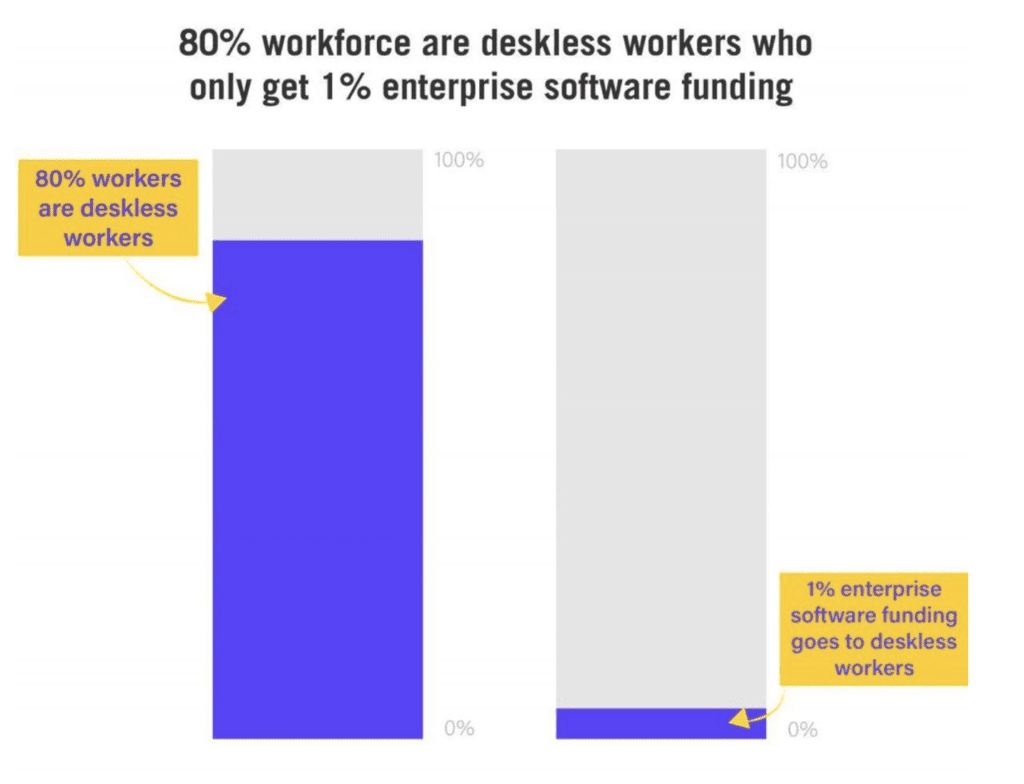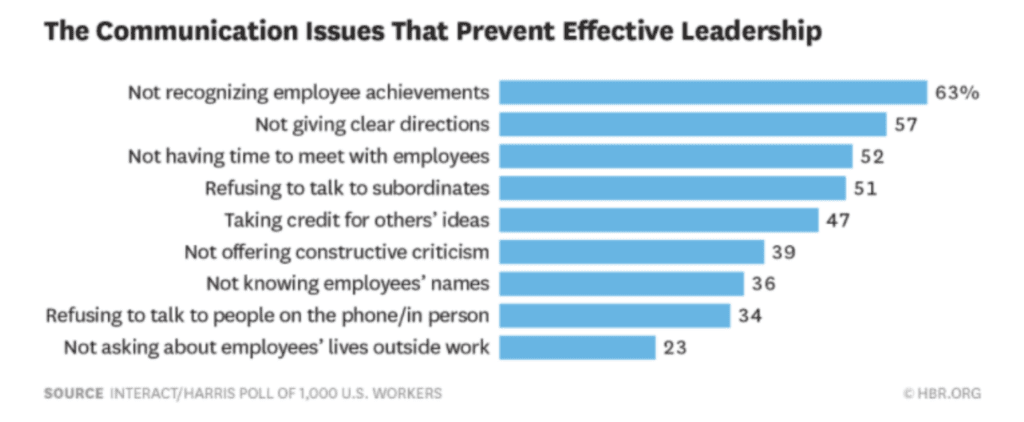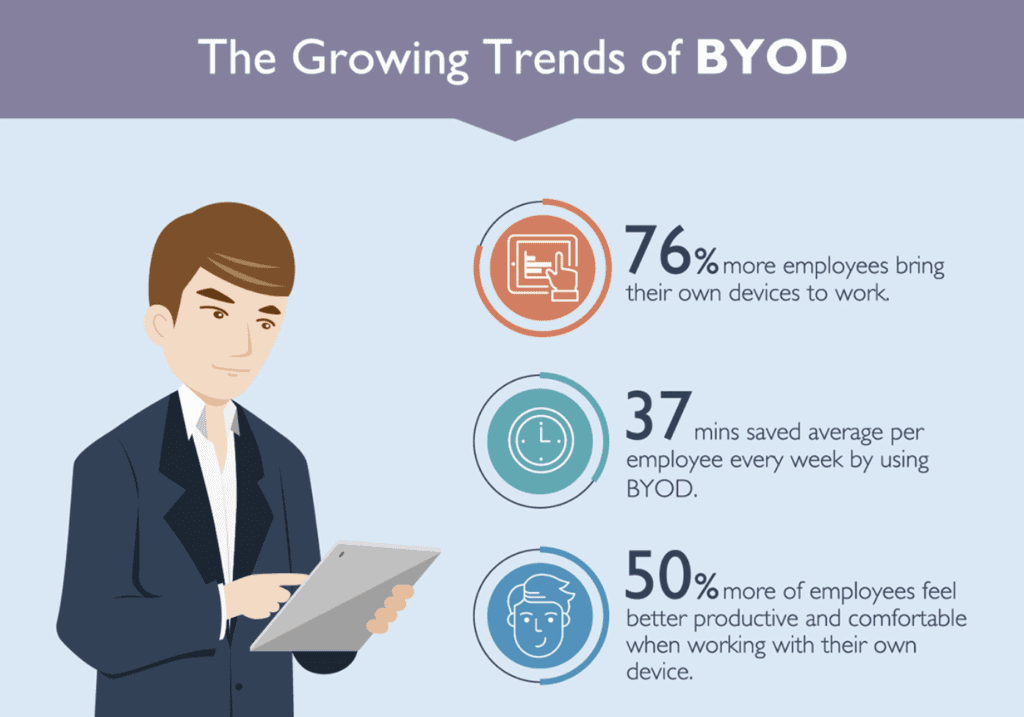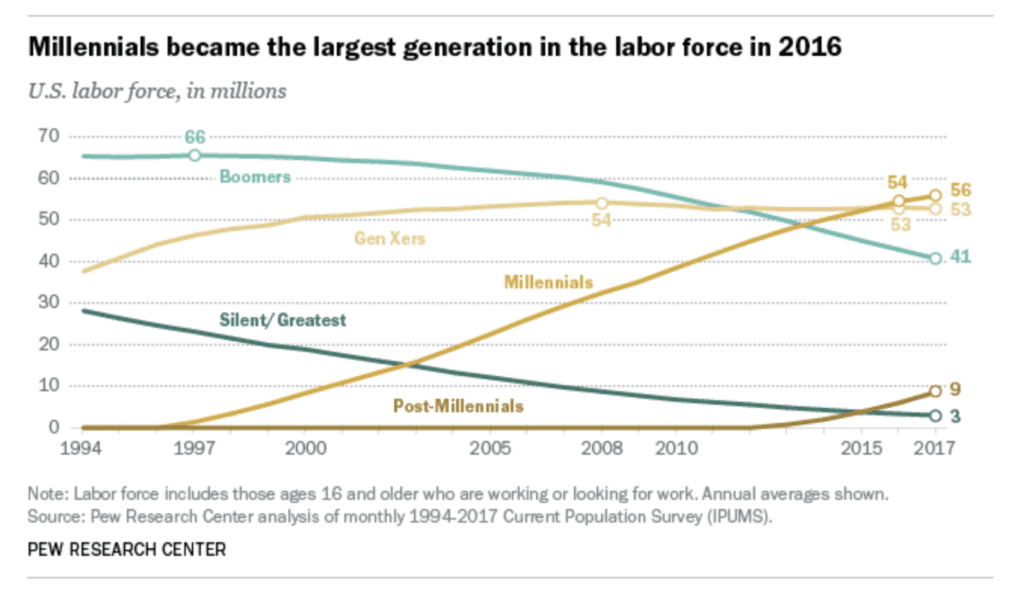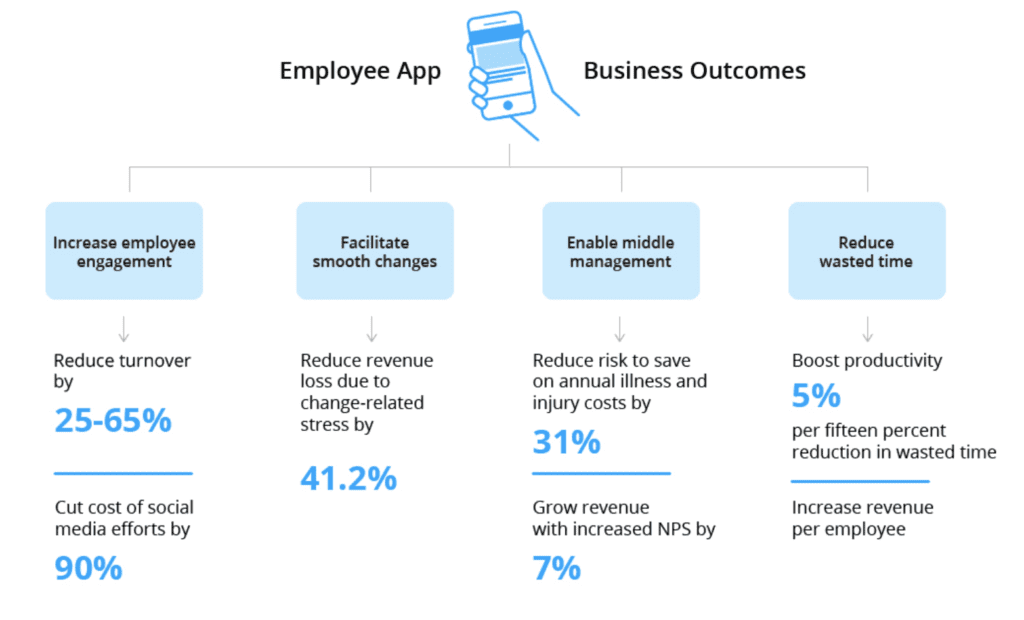Why Your Deskless Workforce Needs a Mobile App

By definition, a deskless worker is any employee who is not seated behind a desk when they’re working. While this definition is quite broad, it’s highly relevant to the majority of businesses so who is a deskless employee?
Some examples of deskless positions include on-site technicians, field sales representatives, delivery drivers, blue-collar workers, and home healthcare providers. Even insurance adjusters need to be on the go to meet clients and contractors on-site at a claim.
The list goes on and on, but the deskless workforce seems to be penetrating companies of all sizes in nearly every industry.
There are countless employees out there who don’t have the option to work in an office. If you consider the amount of field employees who are on the move or work at multiple locations, you’ll see the deskless workforce rate is rising quickly.
Workforce mobile apps are designed to accommodate the needs of blue-collar workers and field employees. This is the best way to get them engaged with your company.
Create a Mobile App for FREE with BuildFire
According to a recent study published by Forbes, 80% of the workforce is considered deskless.
Yet, just 1% of software funding is allocated to these employees. There are obviously some serious flaws with those numbers.
So if your company has deskless employees, you’ll need to change the way that you manage them. This will require you to leverage the appropriate technology.
Your deskless workforce needs a mobile app.
Simply put, you can’t treat remote or field workers the same way as your in-house employees. Plus, even your traditional in-house staff might be deskless a handful of times per month. So a mobile app will ultimately benefit your entire workforce.
For those of you who are interested or on the fence about a mobile app for your remote staff, I’ll explain why this is a must-have technology for nearly every business.
Improve Communication
Deskless employees are different. While this may seem like an obvious statement, a surprisingly high amount of businesses haven’t seemed to recognize and adapt to this quite yet.
Communication is the key to success at any place of business.
However, 79% of workers in the United States say that they are more likely to hear about something through word of mouth in the office as opposed to official communication from management.
Nearly 50% of all workers are not happy with how management communicates with them.
According to a recent study by the Harvard Business Review, these are the biggest communication issues in the workplace.
As you can see, not giving clear instructions and not having time to meet with employees both rank high on this list.
If your business is having so trouble communicating with your staff while everyone is under the same roof, how can you possibly communicate with your deskless employees who are constantly on the go?
With a deskless worker, you can’t just spontaneously stop by their desk or office to give them instructions. You can’t expect them to be at all meetings either.
So what’s your current process for keeping these people up to date or in the loop?
All too often I consult with business owners who don’t really have a system for this. Maybe someone from the meeting sends a follow-up email. But that’s not always helpful or accurate.
Picking up the phone to call a deskless employee can turn into a game of phone tag, which is not an efficient use of anyone’s time.
A mobile app eliminates friction in the communication process. Your deskless staff can be informed in real-time with push notifications and announcements within the app.
This will make them feel like they are still part of the team, even though they aren’t always around or available. It also ensures that they’ll always have access to a clear set of instructions, as opposed to taking notes by hand over the phone during a call with a manager.
Futureproofing Closes Gaps
Your business can’t afford to fall behind the latest technology trends. Failure to adapt now could lead to big problems down the road.
Learning how to leverage technology will help close any gaps or inefficiencies in the workplace.
Once you learn how to futureproof your system, managing deskless employees will become easier than ever before.
If you’re still relying on fax machines, landline phones, and face-to-face communication to manage your workforce, then your process has room for improvement.
You need to take advantage of the technology that your staff is already using on a daily basis. BYOD, short for bringing your own device, has become the new normal in the workplace.
96% of Americans own a smartphone.
The vast majority of employees bring these devices to work, and they feel more productive when using their own devices. So why not take advantage of this?
Your staff is already using their phones at work. So it only makes sense for communication to go through these devices with an app.
An app makes it easier for your deskless workforce to solve problems. They’ll have access to useful resources, guides, customer information, and much more in the palms of their hands.
Your business mobile app can also be used for communicating with team members, keeping track of workflow progress, and updating schedules.
For example, let’s say you have a business that requires your staff to perform work in the homes of your customers. Without a mobile app, your current process might look something like this:
- Your staff has to come into the office.
- Everyone meets with a manager to get assignments for the day.
- They are handed a physical folder with information about the customer and the job.
- Drivers get on the road and head to customers’ houses.
- Work is performed, and notes are manually updated in the customer folder.
- Drive back to the office to drop off notes and customer files.
I know this is pretty broad and non-specific. Depending on your business, there might be a step or two missing, or an extra step that is not required, but you get the picture.
A mobile app will drastically simplify this process. Your staff can just go directly to on-site jobs without having to stop into the office for assignments.
All of the customer information, files, and instructions can be managed within the app. Your staff can even check off tasks like “estimate done” or “job complete” in real-time.
An app will improve your efficiencies and allow your staff to get more done in a day’s work. It also enhances your record-keeping process. Overall, an app is clearly a better solution to the alternative.
Appeal to Millennials
For some of you, this might seem like a strange reason to get a mobile app for your deskless workforce. Why would you need to appeal to Millennials?
Well, as of 2016, Millennials have become the largest generation in the American workforce.
That’s not all. By 2030, 75% of the total workforce will be comprised of Millennials. 2030 isn’t that far away.
Basically, Millennials are going to be working for you. If they aren’t currently the majority of your deskless workforce, they will be in the coming years.
It’s in your best interest to keep your staff happy. Otherwise, they’ll just leave and find another job.
Millennials don’t have the same mindset of generations before them. Their parents and grandparents found a job and stuck with it forever.
But this generation seemingly already has a foot out of the door whenever they start a new job.
According to a recent study, 74% of Millennials believe that constantly job hunting will help their career. 44% of them say they expect to leave their current job within the next 2 years.
70% of Millennials say that they would quit a job based on that company’s sustainability for the long haul.
This relates back to our previous point about future-proofing your business processes. Basically, if your employees think that your business doesn’t have the technology to survive moving forward, they’ll leave.
Plus, Millennials are extremely tech-savvy. They are eager and willing to use technology to improve processes in their personal and professional lives. Offering your deskless workforce a mobile app will be welcomed with open arms.
Get Started With BuildFire Today!
Pick a template to start designing the app yourself, or let our professional design team build it for you.
- Mobile app development for iOS & Android
- No coding required
- 150+ pre-built features
- Unlimited customization
- 14 day free trial
Employee Engagement and Satisfaction
By nature, a happy employee will be more engaged. However, keeping your employees happy is easier said than done. It can be challenging to get people excited about work.
We’ve already discussed that 80% of the total workforce is deskless. However, the needs of the deskless workforce are drastically overlooked.
Just 56% of deskless workers say that they feel connected and engaged with their employers. An additional 27% of deskless employees say that they feel underappreciated.
Why is this the case? It could be for a various amount of reasons, but it all stems back to effective communication, which we discussed earlier.
If you’re not able to see your deskless staff and communicate with them on a regular basis, it’s easy for them to disengage and feel underappreciated. This will ultimately affect the quality of their work. You need to avoid this at all costs.
But how can you possibly engage with someone who you don’t even see on a daily basis?
Mobile apps increase employee engagement.
These numbers speak for themselves. By increasing employee engagement with a deskless workforce mobile app, you’ll reduce employee turnover, increase revenue, and boost productivity.
The success of your business is in the hands of your staff. Too many employers have the mindset that anyone is replaceable, which is why your staff might feel undervalued.
But employee turnover is expensive. Hiring, training, and onboarding a new team member is not always a simple process, especially if its for a deskless position. If you’re unable to improve your processes, then new employees will feel the same way as the ones who left before them.
It’s a vicious cycle that you don’t want to put your company in.
Employee turnover, disengagement numbers, and productivity rates are costing you money. You’d be much better off investing that money into a mobile app. That investment could save you tens of thousands of dollars per year in the long term.
Easy Integration
We’ve already discussed how technology can bridge the workforce gaps between deskless employees and their employers. But with that said, sometimes employees can feel overburdened with too much technology across multiple platforms.
If a company uses lots of different software, deskless employees are forced to navigate across multiple interfaces and platforms. This is not always ideal. By nature, using several different platforms is more complex for a deskless employee. A traditional in-office worker will likely have an easier solution for similar tasks. This can cause a divide between your staff.
That’s why a mobile app is the ideal solution for everyone.
Your internal business app can easily integrate and potentially replace other software that you’re currently using. Both your in-house and deskless workforce will have access to the same information, in real-time, on the same platform.
Training your staff on how to use one mobile app is much easier than teaching them how to use five or six different software solutions.
By consolidating the technology, your deskless workforce won’t need to jump from platform to platform to get work done, which will ultimately increase their productivity.
A mobile app creates a single source of information for things like customer history and job notes. You won’t have to worry about mistakes being made when employees are forced to manually update information across multiple platforms.
Since all data will be coming from one system, it will be much easier for you to analyze everything so you can make informed business decisions. All of the data in the app can also be used to improve the workflow process for deskless employees.
Reduce Costs
To piggyback off of our last point, a mobile app will ultimately benefit your bottom line. At the end of the day, this is really what matters the most.
Cost savings was one of the top reasons why businesses invest in deskless technology.
Increased productivity is a major contributor to saving money.
Think about your current process for managing deskless employees. Earlier, we discussed a hypothetical scenario that involved workers having to report to the office before going out on the road for the day.
Just eliminating that one step could save two hours per day, per deskless employee. If you have 20 deskless workers, that’s 40 hours of labor saved in just one day. Assuming your staff works five days per week, that’s more than 10,000 labor hours per year.
Do the math. Multiply that number by the hourly wages of your deskless staff to see how much money you can save in a year.
This is just one example. Productivity can be increased throughout the entire workflow process as well, ultimately contributing to more hours saved each day, week, and year.
I know what some of you are thinking. Your deskless staff is on salary, so you pay them for at least 40 hours of work regardless.
But with improved productivity, each employee will have increased bandwidth. They’ll be able to complete more tasks on a given day, meaning your company can increase its workload and grow without adding more members to your team. This will allow you to scale back other costs as well.
Enhance Security
Security needs to be a top priority for all businesses. It’s your job to protect any information related to your company, employees, and customers.
Analyze your current process for cracks, leaks, or vulnerabilities in your security systems.
How are you communicating and transmitting sensitive information to your deskless workforce?
This information can be anything from a customer’s home address to an employee’s social security number. Emails, web-based employee portals, and physical documents are not always secure. But a mobile app serves as an added layer of protection for sharing files.
55% of small businesses experienced a cyber attack in the past year and 50% had a data breach. These are the most common types of attacks on businesses.
Mobile app technology can prevent these types of breaches.
Smartphones can use facial recognition, fingerprints, other biometrics to access sensitive information. Your employees will need to verify their identity before viewing something like a paystub.
48% of data breaches were caused by a negligent employee. A mobile app will help add security layers, even when an employee makes a mistake.
For example, if your staff loses a physical file, it could end up the wrong hands. But to access that information on a mobile phone, someone would have to hack both the phone and app. This becomes nearly impossible if a fingerprint scan is required for each.
Improve Accessibility
Not everyone works a traditional 9-5 job.
People work odd hours, especially deskless employees. Some may start early, others may work late nights or weekends. Depending on the nature of the position, some deskless workers may need to be on-call at a moment’s notice.
A mobile app gives them on the go access to everything they need from virtually anywhere. This includes access to real-time information related to the workflow process.
For example, let’s say you have ten employees out on the road performing work on-site at different customer homes. By the nature of your business, the work is ongoing, and you’ll need to be back at each home more than once.
With a mobile app, your staff will have real-time access to scheduling appointments.
This is much more effective than having to follow-up and call your customers while sitting in front of a schedule in the office.
What happens if a customer asks a question that your deskless employee doesn’t know the answer to? No problem. Instead of calling into the office, they can access handbooks and other resourceful guides at their fingertips directly within a mobile app.
Conclusion
You can’t afford to neglect your deskless workforce.
Times are changing, and you need to leverage technology to improve your workflow processes and systems for managing employees.
A mobile app will make it easier for you to communicate with remote workers while simultaneously futureproofing your operation. An app appeals to the majority of your staff, which will increase employee satisfaction and engagement.
It’s easy to integrate a mobile app into your process. This investment will boost your security and lower your costs for the long term by improving employee productivity.
An app gives everyone, including your in-house staff easier access to critical information.
If you’re ready to build a mobile app for your deskless workforce, you can do it using BuildFire’s platform. We have experience building apps to improve communication for field employees.
You can build the app yourself using our system or have our team of experts build it for you.
